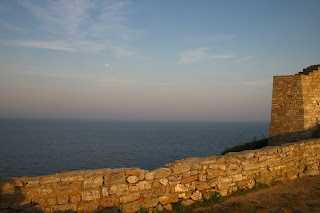May 17, 2011
Kaliakra Cape, Bulgaria
Kaliakra is a long and narrow headland in the Southern Dobruja region of the northern Bulgarian Black Sea Coast, located 12 km east of Kavarna and 60 km northeast of Varna. The coast is steep with vertical cliffs reaching 70 m down to the sea.
Kaliakra is a nature reserve, where dolphins, cormorants and pinnipeds can be observed. It also features the remnants of the fortified walls, water-main, baths and residence of Despot Dobrotitsa in the short-lived Principality of Karvuna's medieval capital.
[Source: Wikipedia]
May 16, 2011
Nesebar, Bulgaria
Nesebar [ancient name: Menebria and Mesembria, Μεσημβρία in Greek] is an ancient town and one of the major seaside resorts on the Bulgarian Black Sea Coast, located in Burgas Province. It is the administrative centre of the homonymous Nesebar Municipality. Often referred to as the "Pearl of the Black Sea" and "Bulgaria's Dubrovnik", Nesebar is a rich city-museum defined by more than three millennia of ever-changing history.
Originally a Thracian settlement known as Menebria, the town became a Greek colony when settled by Dorians from Megara at the beginning of the 6th century BC, and was an important trading centre from then on and a rival of Apollonia (Sozopol). It remained the only Doric colony along the Black Sea coast, as the rest were typical Ionic colonies. At 425-424 BC the town joined the Delian League, under the leadership of Athens.
Remains from the Hellenistic period include the acropolis, a temple of Apollo, and an agora. A wall which formed part of the fortifications can still be seen on the north side of the peninsula. Bronze and silver coins were minted in the city since the 5th century BC and gold coins since the 3rd century BC. The town fell under Roman rule in 71 BC, yet continued to enjoy privileges such as the right to mint its own coinage.
[Source:Wikipedia]
May 15, 2011
Balchik, Bulgaria
Balchik Palace was constructed between 1926 and 1937, during the Romanian control of the region, for the needs of Queen Marie of Romania. The palace complex consists of a number of residential villas, a smoking hall, a wine cellar, a power station, a monastery, a holy spring, a chapel and many other buildings, as well as most notably a park that is today a state-run botanical garden.
Marie of Edinburgh, the wife of Ferdinand I of Romania, visited Balchik in 1921 and liked the location of the summer residence, ordering the vineyards, gardens and water mills of local citizens to be bought so a palace could be constructed at their place. Balkan and Oriental motives were used in the construction of the palace that was carried out by Italian architects Augustino and Americo, while a florist was hired from Switzerland to arrange the park.
The main building's extravagant minaret coexists with a Christian chapel, perfectly illustrating the queen's Bahá'í beliefs.
[Source: Wikipedia]
Subscribe to:
Comments (Atom)














































































































